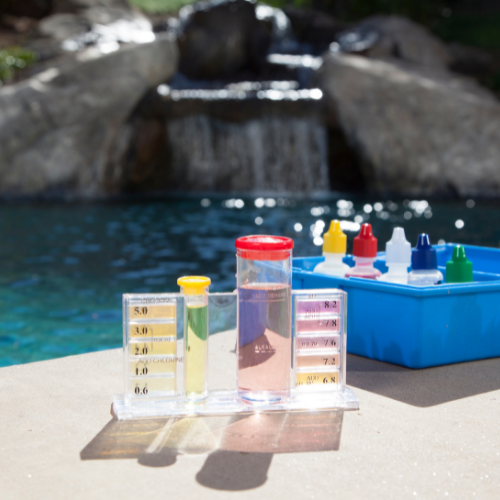How to Winter-Proof your Pool
As the weather gets colder, and the days become shorter. It’s time to start preparing for the colder months ahead. You might have already unpacked your winter clothes and stocked up on firewood, but have you given any thought to getting your pool ready for winter?
Why Should You Prepare Your Pool for Winter?
Getting your pool ready for winter might sound like a lot of work, but a little hassle now will save you a lot of time and money later.
Most regions in South Africa do not experience temperatures below freezing during winter, making it highly unlikely that a pool not prepared for winter will develop problems related to ice, however, a neglected pool during winter can be damaged as much as if it had frozen over.
Pools that aren’t properly prepared for winter become chemically unbalanced creating nasty chemical deposits or in extreme cases, costly damage to your equipment and as well as the fit and finish of your pool.
Taking the time to properly prepare your pool for winter means that when spring comes around, your pool can easily be brought out of hibernation.
Common Mistakes: What Not to do When Preparing a Pool for Winter.
Draining the Pool
In winter, the water in your pool by no means needs to be drained. If treated correctly for winter, the water can serve to protect your pool in a number of different ways all winter long:
Having water in the pool prevents the pool liner from drying out, shrinking and cracking therefore extending its lifespan.
Water provides a damping effect to any falling debris that enters the pool.
If you have an above-ground pool, leaving it full of water over winter will protect the vinyl liner from shrinkage and other damage. Keeping above-ground pools full ensures that the wind will not damage their walls, liner, or frame.
With heavy rains, the ground surrounding an in-ground pool can become waterlogged. This expansion of the soil adds extra pressure on the outer walls of the pool. The weight and force of the water inside the pool counteracts this pressure. Without the opposing force of the water, a drained in-ground pool has the potential to crack or in extreme cases, cave in or even pop out during prolonged heavy rainfall.
Keeping your pool full also prevents the need for a costly complete refill when warmer weather returns.
Not Covering the Pool
Often overlooked because of their cost, pool covers are not always seen as a necessity. However, the cost of maintaining an uncovered pool over the span of a few years will be far more than the cost of a simple pool cover.
A pool cover will stop any leaves or debris from making its way into your pool.
A simple pool cover can protect your pool liner from the elements and prevent it from becoming brittle and fading thus increasing its lifespan.
A good quality cover can prevent excessive amounts of rainwater from entering your pool. Rainwater can affect the chemistry of your pool water in a negative way which may result in algae blooms if not corrected.
A pool cover can reduce your pools demand for chlorine by creating a barrier between the water and direct sunshine which is known to deplete chlorine.
Simple Steps to get your Pool Ready for Winter
Clean Your Pool
Start by brushing the walls and floor of the pool, remove any debris or leaves from the water, and don’t forget to clean the skimmer baskets and the pump baskets. This is also a great time to clean all around the waterline and to get rid of algae if you find any.
Clean The Filter
Give the filter a good clean. The rule of thumb is to backwash once every 2 weeks. Chances are you'll notice that the water that comes out during the backwash is very brown and dirty, this means that you should be doing it a bit more often! Let that backwash run for 2 minutes or until the backwash water turns clear, and remember to use the rinse function for 20 to 30 seconds.
Balance the Water Chemistry
Add Shock to Your Pool Water (Only If Needed)
As the chlorine in your pool water binds to bacteria, it causes the water to turn cloudy. Adding a shock treatment to your pool will oxidise this chlorine, making your water clean and clear again.
If you are adding shock to your pool to prepare it for winter, make sure to wait a week or two before attaching your pool cover, as high levels of chlorine will damage your cover.
Clean All the Pipes leading to the Pump
You want to rid the pipes of any stuck debris or dirt that may cause algae to grow over the winter period.
Clean Your Salt Cell (if you have a Chlorinator)
As a rule, we always recommend chlorinators with a self-cleaning function to our clients. If your chlorinator does not have this function, the salt cells will have to be cleaned every 3-4 months to improve the lifespan of your chlorinator.
Check the Chlorine Level
To keep your pool clean, it’s important to keep your pool’s free chlorine at a level of about 2-3 PPM at all times during winter. If you’re using a saltwater chlorinator, make sure that the salt level is at the optimum level - this differs from brand to brand so make sure that you are familiar with the standard for your chlorinator. Make sure to adjust your chlorinators output accordingly. We would typically recommend an output of about 20 - 25%, depending on your pump run time.
Clean and Store Pool Fittings
Now that your pool is ready for winter, it's time to take care of your pool fixtures. Carefully remove any diving boards, ladders, slides, handrails and so on. Clean them thoroughly before storing them in a safe place for the winter.
Attach Your Pool Cover
You're finally ready to cover your pool. Before applying your cover, make sure that there are no nicks or tears that could compromise the effectiveness of your cover. Carefully guide the cover into place and secure it firmly. Your pool will now be protected until the warmer weather returns. Make sure to remove any excess water or debris that begins to accumulate on top of your cover, as this will add extra strain to your cover and reduce its lifespan.
Run the Pump
Your pool’s pump should be reduced from running 8-12 hours a day to 4-6 hours during the winter period. In our experience, we found this to be the sweet spot regardless of the size of the pool. If your pump is controlled by a timer, make sure to adjust it accordingly.
Keep to a Maintenance Schedule
Once you’ve completed your preparation for winter, make sure that you stick to a maintenance schedule even though it’s cold and the pool is not being used.
Prepare your pool before each big storm by clearing out the leaf baskets and balancing your chemical levels once the storm is over.
A bi-weekly maintenance schedule should be enough to keep your pool clean throughout the winter months if you have a pool cover.
A pool without a cover will have to be maintained more frequently due to leaves and debris finding their way into the water.
Once a week do a quick visual inspection to make sure all of your equipment is working properly. Remember to check the water level and empty the skimmer and pump basket of any collected leaves and debris.
Getting your pool ready for winter is well worth the effort. If you have any questions or would like help getting your pool ready for winter, fill in one of our contact forms.







